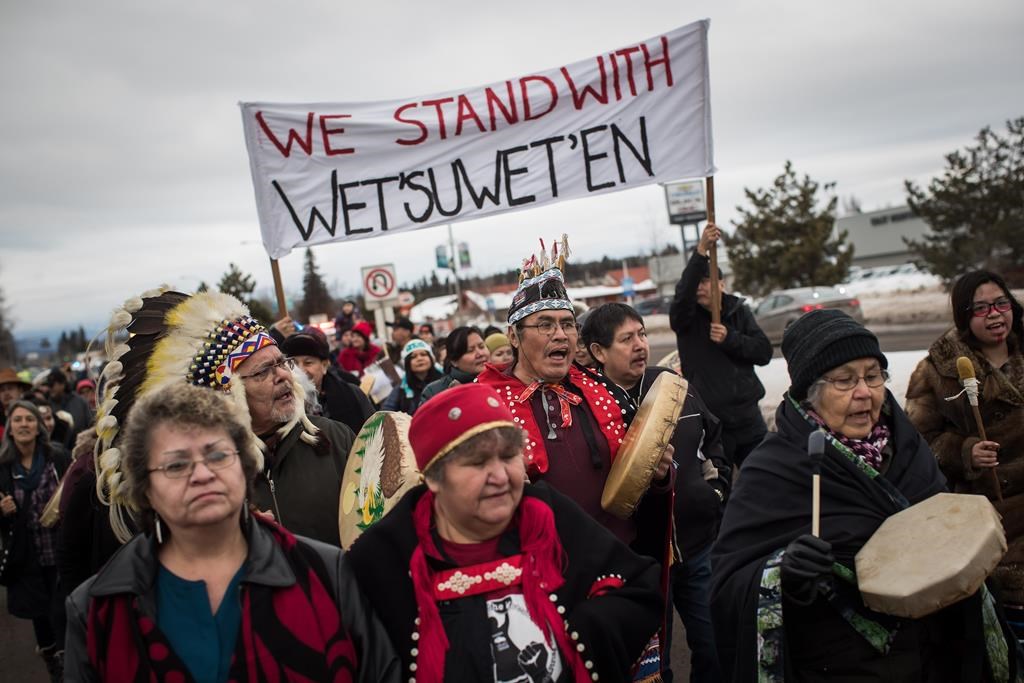
Photo: Facebook/ Wet'suwet'en Access Point
RCMP say the enforcement of an injunction against protesters blocking Coastal GasLink from accessing sites along the Morice West Forest Service Road near Houston, B.C. has concluded with a total of 28 arrests.
RCMP also confirm that one of their officers used a rifle scope to observe members of the Wet’suwet’en and their supporters at one of the occupation camps.
The incident occurred Feb. 7 as RCMP moved in on the Gidimt’en camp, one of several established along the Morice West Forest Service Road, to enforce an injunction against Wet’suwet’en protesters and their supporters who have blocked Coastal GasLink workers from getting to work sites.
Video shot by a Gitxsan man, Denzel Sutherland-Wilson, and posted on Facebook, shows an RCMP officer pointing a scoped rifle at him. Sutherland-Wilson was, at the time, standing on a wooden platform that had been erected above a bus.
His video shows an RCMP tactical squad armed with assault rifles below. One of them, behind what appears to be an overturned vehicle, trains a scoped rifle on Sutherland-Wilson.
“Don’t point your gun at me, please,” Sutherland-Wilson pleads. He then asks media nearby on the ground to try to get footage.
“I have nothing,” Sutherland-Wilson says. “Please take down your weapon. I’m asking you.”
Asked about the incident, Sgt. Janelle Shoihet, media relations officer for RCMP E Division, confirmed in an email that one of the RCMP’s emergency response team (ERT) members had used a rifle scope for observation purposes, despite the fact the officer had binoculars.
“The ERT member deployed during enforcement was tasked with providing over watch and was using the rifle scope as a magnified observation device in a manner consistent with police training,” Shoihet writes.
“The ERT member was briefed prior to the operation and was informed there would be rifles in the protest camp, which were believed to be used for hunting, but could present a threat to police in these tense circumstances.
“Other hazards had been identified along the road and to the bridge which was immediately East of the bus depicted in the video. The bridge itself was found to be sabotaged and could have caused serious harm if used.”
“The ERT member had issued binoculars for observation however due to a rapidly evolving situation, a scope on a rifle affords safety and efficiency to the police officer. In this case, the member was about 100-150m away from the bus.
“The ERT member providing over watch required the use of the rifle with a magnified scope to be able to safely and effectively respond to a threat to the public and police.
“The ERT member did not point the firearm at any protestor during the operation. The rifle scope has a large objective lens which allows the viewer to observe people or objects without pointing a rifle at anyone.”
“The ERT member was required to ensure no lethal threats were present as RCMP Tactical troop members approached the protestors location.”
“Once the ERT member was satisfied the lethal threats to the police were reduced, he transitioned to binoculars and continued to scan the surrounding bush while Tactical Troop members continued the dealing with the persons in the bus.”
Of the 28 people arrested in recent days, all but one have been released without charge.
As of February 11, an exclusion zone that RCMP had been set up along the Morice West Service Road has been removed. Construction work in the area has resumed, according to Coastal GasLink.
““We are extremely disappointed enforcement was required to re-open the Morice River Forest Service Road but will redouble efforts to engage with the Hereditary Chiefs of the Wet’suwet’en and with the Unist’ot’en in search of a peaceful, long term resolution that benefits the Wet’suwet’en people,” the company said in a statement.
Meanwhile, protests in support of Wet’suwet’en hereditary chiefs opposed to the natural gas pipeline project continue to be staged across Canada.
Protesters, which included members of the Canada Palestine Association, occupied the office of B.C. Attorney General David Eby today, February 13, deputy prime minister Chrystia Freeland was blocked by protesters from entering Halifax City Hall Wednesday, February 12, and members of the Tyendinaga Mohawks continue to block CN Railway tracks in Ontario. CN Railways tracks near New Hazelton, B.C. also remain blockaded, although CBC reports that it is to be voluntarily removed today.
Supporters of the Wet’suwet’en members who oppose the Coastal GasLink pipeline have largely drowned out the voices of those Wet’suwet’en leaders who support the project.
All five elected Wet'suwet'en band councils support the project. And while the number of hereditary chiefs who oppose it has grown, some members of the Wet'suwet'en say that's because the hereditary titles of female chiefs who support the project were stripped from them and given to those who oppose the project.
There is some question of whether that is a breach of traditional Wet'suwet'en customs. When granting a court injunction at the end of December, the BC Supreme Court acknowledged that there is some disagreement over who rightfully holds hereditary titles and how they were acquired.
Stewart Muir and Margareta Dovgal of Resource Works has been travelling through Wet’suwet’en territory all week interviewing elders and hereditary chiefs.
“What the protest groups and the Unist'ot'en have been trying to portray about Wet’suwet’en governance and popular support on this issue is completely backwards,” Muir said.
"Traditional law is clear and it's not being respected," Dovgal said. "That's coming through universally. Every single person we've spoken to, whether they are named chiefs all the way to the children of house chiefs, the traditional laws...have just been flagrantly been disregarded."




















